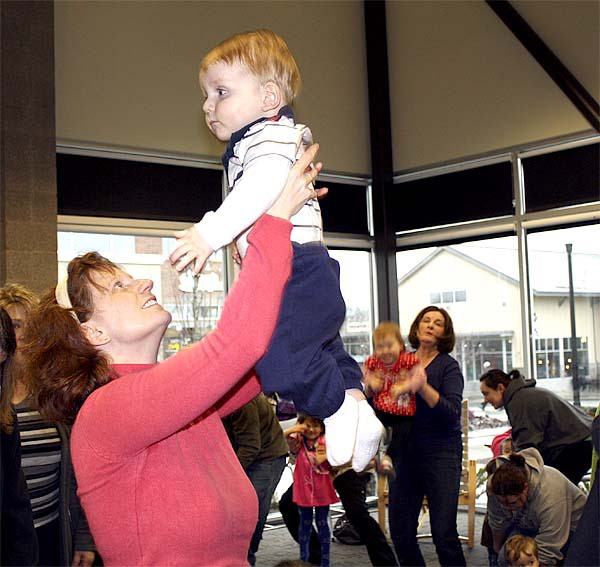Everyone, even the children, knew that the latest school bond had failed by the time school let out Tuesday afternoon, March 8. When Erik Thurston’s mom, Lorraine, came to Cascade View Elementary School to pick him up, he also knew what she was going to say about it, and finished her sentence for her.
“I think the next logical step is…” began Lorraine.
“Run the bond again!” Erik concluded. “Keep on running it till it wins!”
Lorraine wasn’t ready to go that far, but she did think another attempt to address the worsening challenges of a growing school population made sense. Enrollment projections in the Snoqualmie Valley School District increase overall by about 2 percent each year, and the latest U.S. Census results show that 35 percent of the Snoqualmie population is under 18. That represents nearly a 680 percent increase in the under-18 age group since 2000. By comparison, the overall population increased by 543 percent in Snoqualmie, and the youth populations in North Bend and Fall City increased by about 7.5 percent and 18 percent, respectively.
It’s this growing population that got Thurston to throw her support—as a Canadian citizen, she can’t vote—behind the bond to build a new middle school. “When you put upwards of 900 students in a school building, you start to wonder, not about the quality of education, but about the quality of attention they’ll receive.”
The school district could have made better use of its impact-fee revenue, she thinks, because the growing youth population is no surprise to anyone.
“Even three years ago, we knew there were 200 2-year-olds up here on the Ridge… that means 200 Kindergarteners in this school this year,” she said.
A young community
New census numbers show Snoqualmie at 10,670 population. More than 3,700 residents are children. Snoqualmie has the highest youth population, per capita, of any city in King County.
The Valley community of Duvall is second with 33 percent youth population; Carnation is sixth with 30 percent of its 1,786 residents, and North Bend is in 16th place with 26.8 percent children of its 5,731 population.
By contrast, Bellevue, with 122,000 in population, has a 20 percent youth per-capita population. Issaquah, with about 30,000 residents, has a 23 percent youth component.
Even before the numbers came out, Snoqualmie Mayor Matt Larson said the city already intuitively understood that Snoqualmie had a young demographic. The census simply underlines the importance of community centers, parks and schools.
“Look at the complexion of the council itself,” Larson said. “For the past several years, you’ve had a relatively young council with a lot of kids.”
Besides the mayor, five of Snoqualmie’s six-person city council are raising children. That’s not typical for most cities, Larson said.
Snoqualmie’s plentiful parks—the city has 35 of them, totaling 137 acres—reflect a shift in urban planning. Larson said residents who helped set design guidelines for the Snoqualmie Ridge master planned community, source of Snoqualmie’s massive population growth, sought a new urban feel, with spaces for work and play alongside all the housing. Their choices ended up being attractive to young couples and families.
“They look at this and go, ‘It’s a kids’ paradise,'” Larson said. “One fed the other.”
The city has supported Encompass preschool, pushed for a YMCA and dedicated resources to maintaining first-class parks. Larson pointed to the Snoqualmie Police Department’s presence at the annual Tanner Jeans Memorial Foundation Bicycle Safety Rodeo as an example of youth-minded community policing.
Playfield crunch
Snoqualmie’s new numbers also confirm what city parks employees are seeing in the field—capacity use of local playfields.
“There is a real crunch, especially when it comes to field space,” said Gwen Voelpel, parks director for the city of Snoqualmie. “Even with as much as Snoqualmie has, we’re running out of capacity. We have leagues that want to form new teams, but don’t have places for them.”
Snoqualmie is planning a new community park next to the Eagle Pointe neighborhood in Snoqualmie Ridge’s Phase II, with the potential for two soccer and one football field.
“We’ll still have needs beyond that,” Voelpel said. “It’s going to continue to be a crunch for quite a while for our youth.”
Si View Metro Park District’s new playfields and school district fields like that at Mount Si High School, which is artificial turf that can be played on 24 hours a day, are “huge assets for the community,” Voelpel said. “But even they are feeling the pinch.”
Snoqualmie is considering an infrastructure bond, asking for help from taxpayers to pay for pipe and street fixes. Playfields could be a part of that, if the community has an appetite for a tax fix.
One hanging question: “Where are we going to get the land?” Voelpel asked. Flood-free areas are hard to find, even in a recession.
“It’s not that it can’t be done,” Voelpel said. “The price and availability is prohibitive.”
• Next week, see how Valley schools, police and youth organizations are handling the youth boom.



